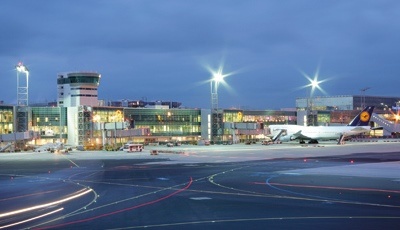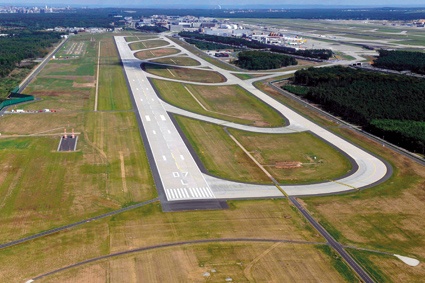Frankfurt Airport: Perimeter Protection 24/7
Calibration and Training Fraport AG not only manages the largest airport in Germany. With approximately 78,000 employees, the Frankfurt airport is also the largest local job site...


Calibration and Training Fraport AG not only manages the largest airport in Germany. With approximately 78,000 employees, the Frankfurt airport is also the largest local job site in Germany. In 2012 Frankfurt was ranked 11th in the world with regard to the number of passengers and 9th with regard to cargo volume. The huge premises covers more than 21 square kilometres, which are protected among other things using Flir thermal imaging cameras.
New Runway, New Security Concept
As part of the Frankfurt airport expansion programme with the new North/West runway, a uniform impermeable security concept was required for perimeter protection of the new area. The guidelines laid forth by the responsible regional aviation authority - in this case the Hessian Ministry of Economics, Energy, Transport and Federal State Development - and the ICAO (International Civil Aviation Organization), as well as structural conditions on site, it was clear that only a combination of different technical solutions would be sensible for perimeter protection. The solution would have to consist of fences, CCTV cameras and thermal imaging cameras. Therefore, Fraport's purchasing division invited various manufacturers to present their products in a large-scale test run. Torsten Siats, who is responsible for telecommunications, radio & CCTV at Fraport, remembers: „There were probably 4-5 fence manufacturers and at least 5-6 video systems providers, who presented their products under the same conditions. About 40 different cameras were hung on two masts and a perimeter route was spanned between the masts with different types of fences."
Test Run With Weather Simulation
Manfred Reinhard, who works in Fraport's aircraft and terminal management and enterprise security division, adds with a smile: "In our test run, we have the unusual ability to simulate an extremely wide range of weather conditions from tropical rain to the finest fog using our large Simba fire trucks." These experimental simulations also clearly confirmed that a combination of various perimeter protection measures is ultimately useful because each technology had different strengths and weaknesses. "Under normal daylight conditions, we can recognize possible hazards most easily using CCTV cameras. But they show weaknesses at night and in adverse weather conditions", explains Manfred Reinhard and his colleague Torsten Siats adds: "Thermal imaging cameras work very well day and night and even in cases of light fog or smoke, but they also reach their limits during tropical rainstorms. In this case the water acts as a wall which is impermeable to thermal radiation."
The Security Concept
The test run resulted in a detailed security concept. Fraport opted for a combination consisting of a fence, over 50 CCTV cameras and about 40 thermal imaging cameras in sensitive areas of the security perimeter. The technical planning phase had been product-neutral, but now it was time to choose suppliers for the various products. The market leader FLIR Systems was awarded the contract for the thermal imaging cameras. In October 2010 the FLIR F series was implemented - at first only with a field of vision of 48° and an infrared resolution of 320 x 240 pixels.
One important aspect for Fraport's technical department, was that the cameras be easy to start operating. Therefore they were initially connected using analogue technology and installation was carried out by the installation company SAM. Another important selection criteria was that the cameras should have both an analogue video port and an IP network connection. Now all FLIR F series cameras are controlled as IP cameras using their internal encoders. Fraport's technology department provided Flir with valuable suggestions for the encoder's user interface.
Rain Protection
Due to the fact that the cameras were installed in an almost horizontal position and on an open stretch of land at the airport site, the cameras were exposed to strong lateral winds from the Flir F series cameras are equipped with sun and rain protection by default. However, this can't be extended so an employee in Fraport's video department designed their own technical solution. "We should have patented it", explains Manfred Reinhard with a grin, because Flir has now implemented this concept for adjustable sun and rain protection in its FC series S.
Practical System for Removable Camera Cassettes
Yet another subsequent change was required. Fraport needed thermal imaging cameras for some selected locations to have a wider range. The Flir F-324 model was particularly suited for this job with its 19 mm lens, which can detect an object the size of a person at a distance of almost 500 m. The design of the FLIR F series was ideal for replacing the camera unit. Flir has developed a practical cassette system, which enables users who need a higher viewing/opening angle to make the required modification without having to buy a completely new camera system. Therefore sensors and lenses can be quickly upgraded or repaired. Users do not have to return their camera and upgrading or replacing the cartridge only takes a few minutes.
Data Protection
Thermal imaging cameras are also interesting with regard to data protection. They don't show individual features, but only depict "temperature signatures". Therefore, they can be used in all cases requiring special data protection, as they are not problematic in this regard as compared to CCTV cameras.
Calibration and Training
Proper calibration of all the cameras was a complex task, as it actually requires a full cycle of the seasons. The conditions in winter are completely different than in a hot summer and a wet autumn is different from spring. When it comes to calibrating thermal imaging cameras, the most important factors are not, as one might think, the extremely high or low temperatures. The medium temperature range is actually much trickier because there is not such a big difference in temperature between the environment and objects. It is also important to take into consideration that the cameras are not accessible to service personnel at all times, because they would trigger alarms and because airport operations should not be interrupted. In order to best calibrate the cameras and for a better understanding of the underlying technology, Marcel Wiechmann of Flir's Infrared Training Center (ITC) trained the Fraport employees in an in-house workshop on location.
Detection and Software
The task of the cameras of course consists first and foremost of reliably detecting potential intruders. "Priority number one: If someone or something violates the airport's perimeter, then the system has to detect it", explains Bernhard Amthor, who is responsible for video among other things in Fraport's Information & Communication department. "Priority number two: If this is not the case, then no alarm should be sounded. The number of false alarms should always be kept to an absolute minimum to ensure efficiency. Of course this never works 100% and that can sometimes even have charming aspects. For example, there is a lonesome fox that makes its rounds around the fence every night at a certain time and has become a good friend for the Fraport team. It is detected as such and no alarm is sounded."
An alarm involves a whole chain of software. When the Flir infrared camera detects motion, an alarm is triggered in the Aimetis system. The motion detection system made by Aimetis is able to distinguish between movements in different directions. Often only movement in a certain direction is defined as unusual. Therefore landing planes do not mistakenly trigger an alarm for example. Therefore the Aimetis software can be configured so that only certain direction-specific movements are reported. The software then sends such an event to the video management system (VMS) provided by the company Schille. The VMS forwards the event to the security control center's deployment system - and only then is deployment initiated.
Maintenance, Warranty and Energy Efficiency
The Flir cameras are basically maintenance-free, but Fraport services all its cameras twice a year and it makes no exception for the F series cameras. Flir provides a 2-year warranty on the current cameras and even a 10-year warranty on the detectors (after registration of the camera after purchase). This is also good news for the controlling department, because the purchase and replacement costs are spread over a longer period of time. When it comes to operating costs, thermal imaging cameras are unbeatable despite their higher purchase price compared to CCTV cameras. Additional spotlights and the masts to mount them on are unnecessary because no additional illumination is needed. Infrared cameras can "see" even in the darkest conditions. This energy efficiency is well aligned with the "Airport Environmental Partnership" program, in which Fraport has joined airline companies, energy suppliers and the German air-traffic control to contribute to climate protection.
Business Partner
FLIR Systems, Inc.27700 SW Parkway Avenue
Wilsonville, OR 97070
US
most read

GIT SECURITY AWARD 2026 - The winners have been announced!
GIT SECURITY AWARD 2026: The best safety and security solutions of the year - now an overview of all winners


Is Your Venue Ready for Martyn’s Law?
Martyn’s Law demands stronger security by 2027. Is your venue prepared to protect and respond?

Security management, building security & perimeter protection: the winners of category E at the GIT SECURITY AWARD 2026
GIT SECURITY AWARD 2026: Security management, building security & perimeter protection - an overview of the most innovative solutions









